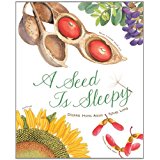 A Seed is Sleepy by Dianna Hutts Aston is an introduction to seeds and the life cycle of plants in a unique way that has a wide appeal. It combines poetic phrases with factual prose and vivid illustrations, to produce an experience that is both educational and aesthetic. Written for children ages five to eight in grades kindergarten to third grade, the book is a valuable resource for teachers and parents alike.
A Seed is Sleepy by Dianna Hutts Aston is an introduction to seeds and the life cycle of plants in a unique way that has a wide appeal. It combines poetic phrases with factual prose and vivid illustrations, to produce an experience that is both educational and aesthetic. Written for children ages five to eight in grades kindergarten to third grade, the book is a valuable resource for teachers and parents alike.
Taking an anthropomorphic approach, the two page spreads begin with a simple phrase in large cursive writing “A seed is…” followed by an attribute such as adventurous, inventive, and thirsty. This is accompanied by a factual paragraph in smaller block letters explaining the attribute and by numerous large labeled pen and watercolor illustrations visually extending the presentation. A series of drawings show the life cycle of a plant and a large diagram of a bean illustrates the anatomy of seed and embryo. My favorite feature of the book is the many different kinds of seeds that are shown from cocklebur to maple and milkweed. What a wonderful opportunity to introduce children to the diversity of seeds.
Much as I love the book in general as a former high school biology teacher I wonder if an anthropomorphic approach is a good one to use with small children who may cling to this concept long after it is useful. The use of cursive is another issue since it is slowly becoming obsolete and not even taught in many school so young children may not ever be able to read it. Factually, the book makes no distinction between fruits and seeds, and says seed are naked, when this is true only of gymnosperms that are represented by 1000 species as compared to angiosperms (grasses, flowers, vegetable plant all with enclosed seeds) with almost three hundred thousand species. Despite these criticisms, I enjoyed the book and think it offers a great introduction to plants in general and seeds in particular.
To buy A Seed is Sleepy from Amazon.com Click Here.